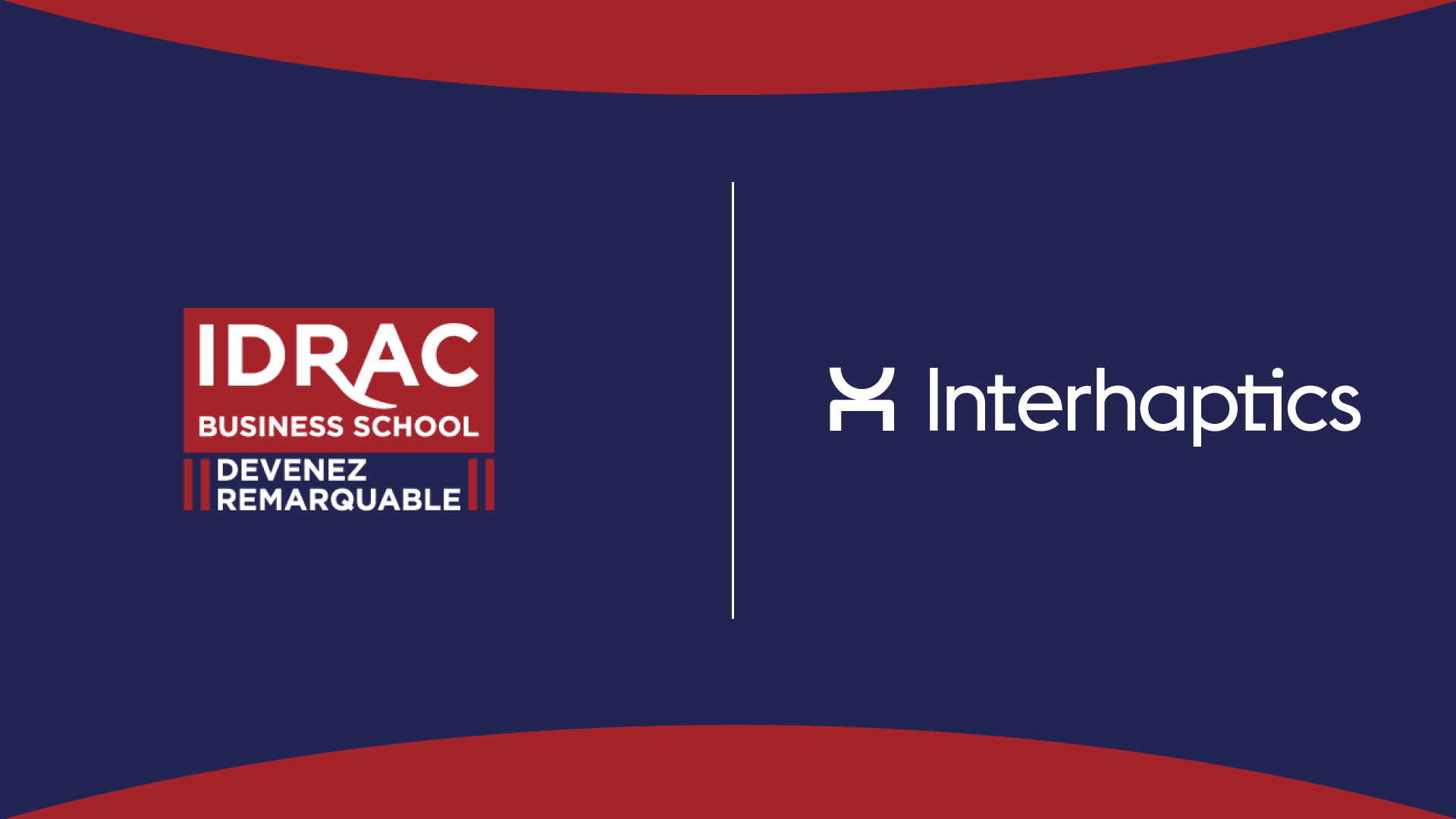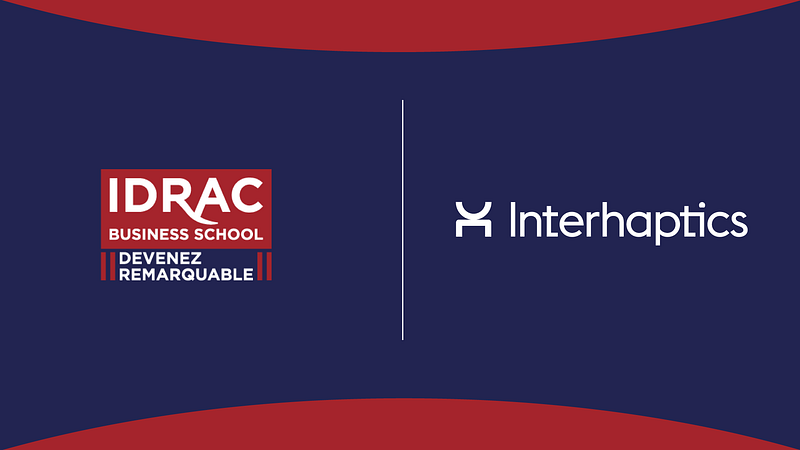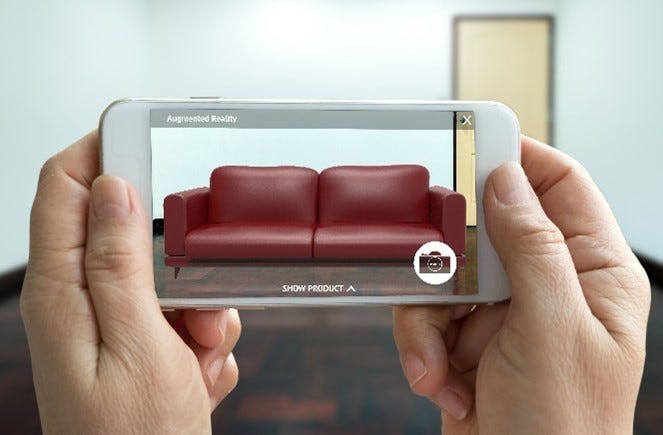

Interhaptics and IDRAC Business School collaborate to study the impact of haptics on E-commerce, by adding haptic feedback in augmented reality. Thanks to Interhaptics, Margot Racat, Ph.D. and Marketing Professor at IDRAC Business School, Lyon Campus, will test high-quality haptic feedback in augmented reality in a variety of e-commerce research applications. The objective is to study the impact of haptics on the customer purchase experience and provide actionable managerial insights for marketing managers in an era of multi-, cross- and omnichannel environments via interfaces. The haptics android & Iphone is also tested with the applications.
When people compare the differences between offline and online shopping, they often mention the lack of authenticity of the experience, due to the importance of the touch and feel of the product.
During the year 2020, the pandemic has raised further awareness about the importance of touch in everyday interactions and particularly for business interactions: salespersons and customers, product examination, information processing, etc. This sudden rise of notoriety has been coupled with the large success of the Haptics technology included in the PS5 recently released. Both concur to increase customers’ awareness and expectations of digital touch technologies.

Research about haptic feedback in augmented reality for e-commerce
Today’s haptic feedback for augmented reality is limited, in particular for mobile devices even if haptic android & iphone are getting developped, but indications are suggesting that it can contribute to increasing the e-commerce customer experience. For instance, previous research has demonstrated the effect of tactile screen devices on customer brand engagement, choice, psychological ownership, or endowment[1].
In this research, we aim to examine how a well-designed and qualitative haptics feedback in augmented reality, via haptic rendering and haptic texturing, can increase customer engagement, experience, and purchase intention in online environments. All with respect to the visual characteristics of the product. Therefore, this collaboration aims to methodically measure the impact of haptic rendering technology and quantify its value for e-commerce experiences with real-time setup.

IDRAC Business School is a French private school with 8 campus sites (Bordeaux, Grenoble, Lyon, Montpellier, Nantes, Nice, Paris, Toulouse). It offers Business and Marketing programs, with various specializations such as Management, Supply Chain, Sales and so on. Being international is a part of its DNA, with 8 associate campuses and more than 100 exchange partners in 41 countries. The Research Department is composed of full time PhD professors working on the business models of tomorrow.
As one of its professors, Margot Racat, Professor of Marketing, has based her research work on the importance of sensory influence on information processing in marketing contexts. She holds a Ph.D. in marketing from University Jean Moulin Lyon 3, and her research interest includes knowledge acquisition and information processing via the human senses and within computer-mediated environments. Collaborating with Interhaptics allows a higher and up-to-date research using the latest techniques that will further integrate our shopping environments, where physical and virtual realities tend to merge. As well, this collaboration intends to deliver new, different and remarkable insights for customer experience and managers.
“We consider haptics rendering and texturing techniques as a way to understand the value of the sense of touch for customers in an online shopping context. The definition of the sense of touch is still ongoing and even more with the implementation of mediated interaction and virtual environments for all aspects of life (medical, food, shopping, social interaction, etc.). The health context has changed habits and opened new perspectives for customers and businesses. We can take the example of Apple, which in the past has emphasized the touch design to become a brand asset and has now brought the latest possibilities to the customer’s hand for haptics sensation in a consumption context. Yet, the main issue to date is that most people developing haptics come from the field of computer sciences or engineering and generate a “user” understanding of haptic feedback but not social nor consumer-based related. Now, social sciences are much more involved into research on haptic as an activator for the customer. If you look at the consumer goods market, smartphones are probably the most use of mobile devices for online shopping now. Why? Because it has become over time the simplest and ‘at-hand’ interface. However, we need to understand and evaluate how much consumers can overcome the tech barrier in their use of e-commerce, same for marketing managers who need to rethink their product online strategy, especially for material-based products. We think the sense of touch is inevitable for the consumers full acceptation and adoption of online shopping via the transfer of touch sensations — whether or not related to the product tactile cues — and that’s why we use haptic rendering and texturing today, to further explore the future of touch.”
Dr. Margot Racat

Interhaptics is a software company specializing in Haptics. Interhaptics provides hand interactions and Haptic feedback in augmented reality and deployment tools for XR, mobile like haptic android & iphone, and console applications.
“The value of haptics to increase customer engagement for e-commerce has been speculated for long. Thanks to Interhaptics we can provide a solid technological framework to allow researchers to study e-commerce applications of Haptics. We are looking forward to this collaboration.”
Eric Vezzoli, Interhaptics CEO & Founder
If you have a project and would like to collaborate and integrate your devices with Interhaptics contact us here.
References
Brasel, S. A., & Gips, J. (2014). Tablets, touchscreens, and touchpads: How varying touch interfaces trigger psychological ownership and endowment. Journal of Consumer Psychology, 24(2), 226–233. https://doi.org/10.1016/j.jcps.2013.10.003
Brasel, S. A., & Gips, J. (2015). Interface Psychology: Touchscreens Change Attribute Importance, Decision Criteria, and Behavior in Online Choice. Cyberpsychology, Behavior, and Social Networking, 18(9), 534–538. https://doi.org/10.1089/cyber.2014.0546
Pagani, M., Racat, M., & Hofacker, C. F. (2019). Adding Voice to the Omnichannel and How that Affects Brand Trust. Journal of Interactive Marketing, 48, 89–105. https://doi.org/10.1016/j.intmar.2019.05.002
Racat, M. (2016). L’influence de la stimulation tactile lors de l’évaluation en ligne d’un produit. University of Lyon.
Racat, M., & Capelli, S. (2016). L’impact de la similarité sur l’efficacité des outils d’aide à la vente en ligne. Revue Française de Gestion, 42(254), 89–105. https://doi.org/10.3166/rfg.2016.00005
Racat, M., & Capelli, S. (2020). Haptic Sensation and Consumer Behaviour. Springer International Publishing. https://doi.org/10.1007/978-3-030-36922-4
Shen, H., Zhang, M., & Krishna, A. (2016). Computer Interfaces and the “Direct-Touch” Effect: Can iPads Increase the Choice of Hedonic Food? Journal of Marketing Research, 53(5), 745–758.






